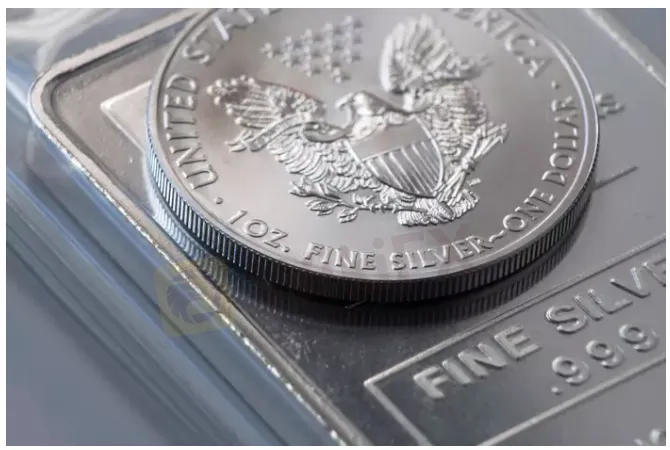简体中文
繁體中文
English
Pусский
日本語
ภาษาไทย
Tiếng Việt
Bahasa Indonesia
Español
हिन्दी
Filippiiniläinen
Français
Deutsch
Português
Türkçe
한국어
العربية
Inflation Is Killing Silver
Abstract:More than just a few people are buying silver because “it protects them from inflation” – or something to that effect.

Ever wonder if that argument holds up? The chart below indicates otherwise…
Silver Prices (inflation-adjusted) – 50 Year Historical Chart (1)

According to the chart, it appears that silver continues to be pressured downwards as inflation gets worse. Where is the fundamental or technical appeal in that kind of price action?
Here is the same chart with the addition of a downward sloping line connecting the major silver price peaks dating back to 1980…
Silver Prices (inflation-adjusted) – 50 Year Historical Chart (2)

Most investors dont consider inflation-adjusted pricing in their expectations or calculations for silver. The argument given is that silver prices will go a lot higher as inflation gets worse, but there is no historical indication of that.
Price-conscious investors are usually looking at other charts, such as the one below…
Silver Prices – 50 Year Historical Chart (3)

The chart immediately above shows the long-term uptrend in silver prices since May 1970 from $1.61 oz to $22.31 oz currently. It is possible to be swayed by the numbers, but the numbers arent that good anyway.
On an inflation-adjusted basis the numbers are worse. Allowing for the effects of inflation, the increase isnt even 2-to-1 ($22.31 divided by $11.96 = 1.86).
How excited can anyone be to own an investment that has almost doubled over the past fifty-two years (a 1.2% annual rate of return)?
The effects of inflation have recently done considerable damage to longer-term holders of silver.
For example, the average monthly closing price for silver in August 2011 was $41.76. The current, comparable inflation-adjusted price is $52.99 oz.
That means that the current silver price is forty-seven percent lower than it was in August 2011; and in inflation-adjusted terms it is fifty-eight percent lower.
Silver Price Uptrend
In chart number (3) above, there is a definite uptrend in nominal silver prices (prices not adjusted for inflation). Here is the chart with the addition of that uptrend line…
Silver Prices – 50 Year Historical Chart (4)
The uptrend line is clearly defined; even so, a drop in silver prices could go as low as $8.00 oz. without breaking it.
That ($8.00 oz) may seem far-fetched, but it is no more unrealistic than silver price projections of $100.00 oz. or more.
Silver – Up or Down?
Whether the silver price is headed higher or lower from here is hard to say. It could go either way in the short term. In the long term, though, silver has lots of room on the downside.
Since its peak in 1980 silver has not matched the effects of inflation, let alone produced any real profits. Silver price history doesnt support current expectations for higher prices, but there are some painful examples of horrendous drops in price.
What Could Cause Silver to Drop
Silver has a history of lower prices regardless of economic conditions.
During The Great Depression (1930s) silver reached a low of $.28 oz.
Several decades later, in the middle of the greatest period of economic growth in US history (1980-2000), silver fell from nearly $50.00 oz. to under $3.00 oz. That is a drop of ninety-four percent without factoring in the effects of inflation.
Currently, the arguments in favor of higher silver prices are not consistent with the tale of history.
Any sustained movement in the direction of more moderate effects from inflation, or the occurrence of deflation, could take the silver price much lower.
If the US economic activity improves to any measurable degree, it would not provide any impetus for a higher silver price.
All factors considered, there isnt a strong argument for higher silver prices. And, yet, inflation continues to erode real value from silver as its inflation-adjusted price continues to weaken over time (see chart number (2) above).

Disclaimer:
The views in this article only represent the author's personal views, and do not constitute investment advice on this platform. This platform does not guarantee the accuracy, completeness and timeliness of the information in the article, and will not be liable for any loss caused by the use of or reliance on the information in the article.
Read more

Top 10 Trading Indicators Every Forex Trader Should Know
Master the top 10 Forex trading indicators to analyze real-time Forex quotes, trends, and market signals. Learn strategies to boost accuracy and avoid mistakes.

Geopolitical Events: What They Are & Their Impact?
You've heard many times that geopolitical events have a significant impact on the Forex market. But do you know what geopolitical events are and how they affect the FX market? Let us learn about it today.

Why Do You Feel Scared During Trade Execution?
Trade execution is a pivotal moment for traders. It is when analysis turns into action, and potential profits or losses become reality. However, for many traders, this moment is accompanied by fear. Why does this happen, and how can you address it?

WikiEXPO Global Expert Interview: Simone Martin—— Exploring Financial Regulation Change
In the midst of financial innovation and regulation, WikiGlobal, the organizer of WikiEXPO, stays abreast of industry trends and conducts a series of insightful and distinctive interviews on pivotal topics. We are delighted to have the privilege of inviting Simone Martin for an in-depth conversation this time.
WikiFX Broker
Latest News
Geopolitical Events: What They Are & Their Impact?
Top 10 Trading Indicators Every Forex Trader Should Know
ASIC Sues Binance Australia Derivatives for Misclassifying Retail Clients
Why Do You Feel Scared During Trade Execution?
Revolut Leads UK Neobanks in the Digital Banking Revolution
Currency Calculator


